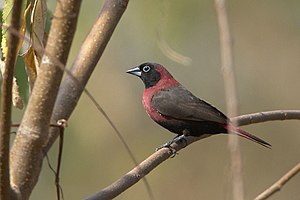Larval amaranth
| Larval amaranth | ||||||||||||
|---|---|---|---|---|---|---|---|---|---|---|---|---|

Larvae amaranth ( Lagonosticta larvata ) |
||||||||||||
| Systematics | ||||||||||||
|
||||||||||||
| Scientific name | ||||||||||||
| Lagonosticta larvata | ||||||||||||
| ( Rüppell , 1840) |
The larval amaranth ( Lagonosticta larvata ) is an African species from the finch family . Since this species was very often kept as an ornamental bird, especially in the 19th century, a number of German names have become established. It is also called larvae , burgundy amaranth , burgundy astrild , black- throated amaranth or black-throated amaranth . There are several subspecies for this species; however, the exact number of subspecies is still debatable. The black-throated amaranth is occasionally listed as an independent species, Lagonosticta vinacea .
description
The larval amaranth reaches a body length of eleven centimeters. In the male, the sides of the head, the throat and the forehead are black. The top of the head is gray, the back and the wings are grayish wine-red. The upper tail-coverts have a dark red color, the wings are gray-brown. The middle tail feathers are completely red, the rest only on the outer flags and otherwise blackish. The beak is blue-gray with a black tip. The females lack the black face mask. Their heads and throats are yellowish gray. Both sexes have small white spots on the sides of the body.
Distribution and way of life
The distribution area of the larvae marant stretches in a narrow band from Gambia to southern Senegal , the inland areas of Ghana , Togo , central Nigeria to northern Cameroon , the Central African Republic , southwest Sudan to the extreme northeast of the Congo, northern Uganda and Ethiopia .
The habitat of the larvae amaranth is grassland with tree cover and in Gambia and Ethiopia also bamboo stands. The altitude distribution extends to altitudes of 1550 meters. Occasionally they can also be found on fallow and overgrown millet fields. They usually live in pairs or in small family groups. They are occasionally associated with other amaranth or butterfly astrals. Their food is grass seeds between one and two millimeters. They also eat termites . To search for food they go to the ground.
The breeding season varies depending on the distribution area. The courtship is - as is typical for Amaranten - a halmbalz that usually takes place on the ground. The male hops around the female while it carries a blade of grass or a feather in its beak. The clutch consists of three to four white eggs. They are incubated for about two weeks. The nestling period is eighteen to twenty days.
attitude
The subspecies Lagonosticta larvata vinacea , which is known as wine red amaranth in German-speaking countries, was regularly available in stores, especially in the 1880s and 1890s. It is the most colorful subspecies. The male's black mask contrasts particularly strongly with the wine-red breast. This subspecies is the most commonly kept subspecies to this day. They are now also being bred to a greater extent, as larval marants are generally good and reliable breeding birds. They are considered to be a very compatible species that can be kept in a communal aviary with other fine finches.
supporting documents
literature
- Jürgen Nicolai (Ed.), Joachim Steinbacher (Ed.), Renate van den Elzen, Gerhard Hofmann, Claudia Mettke-Hofmann: Prachtfinken - Afrika , Series Handbuch der Vogelpflege, Eugen Ulmer Verlag, Stuttgart 2007, ISBN 978-3-8001- 4964-3
Single receipts
Web links
- Lagonosticta larvata inthe IUCN 2013 Red List of Threatened Species . Listed by: BirdLife International, 2012. Retrieved February 2, 2014.